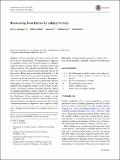Recovering from failure by asking for help
Author(s)
Tellex, Stefanie; Li, Adrian; Knepper, Ross A.; Roy, Nicholas; Rus, Daniela L
Download10514_2015_Article_9460.pdf (2.766Mb)
OPEN_ACCESS_POLICY
Open Access Policy
Creative Commons Attribution-Noncommercial-Share Alike
Terms of use
Metadata
Show full item recordAbstract
Robots inevitably fail, often without the ability to recover autonomously. We demonstrate an approach for enabling a robot to recover from failures by communicating its need for specific help to a human partner using natural language. Our approach automatically detects failures, then generates targeted spoken-language requests for help such as “Please give me the white table leg that is on the black table.” Once the human partner has repaired the failure condition, the system resumes full autonomy. We present a novel inverse semantics algorithm for generating effective help requests. In contrast to forward semantic models that interpret natural language in terms of robot actions and perception, our inverse semantics algorithm generates requests by emulating the human’s ability to interpret a request using the Generalized Grounding Graph (G[superscript 3]) framework. To assess the effectiveness of our approach, we present a corpus-based online evaluation, as well as an end-to-end user study, demonstrating that our approach increases the effectiveness of human interventions compared to static requests for help.
Date issued
2015-08Department
Massachusetts Institute of Technology. Computer Science and Artificial Intelligence Laboratory; Massachusetts Institute of Technology. Department of Aeronautics and AstronauticsJournal
Autonomous Robots
Publisher
Springer US
Citation
Knepper, Ross A., Stefanie Tellex, Adrian Li, Nicholas Roy, and Daniela Rus. “Recovering from Failure by Asking for Help.” Auton Robot 39, no. 3 (August 6, 2015): 347–362.
Version: Author's final manuscript
ISSN
0929-5593
1573-7527